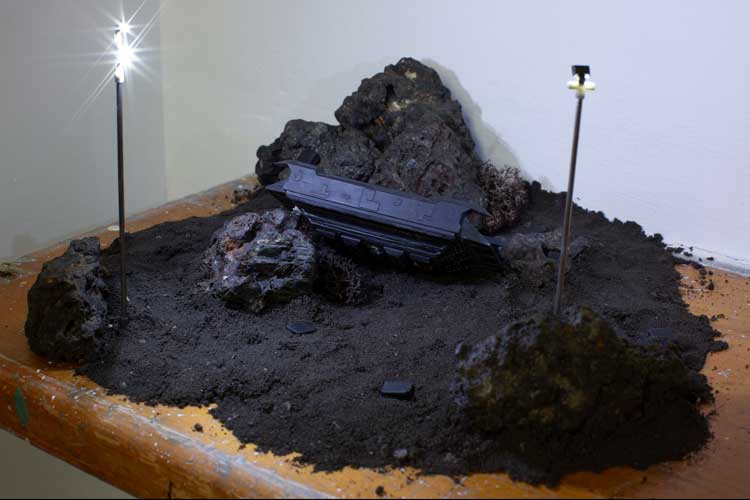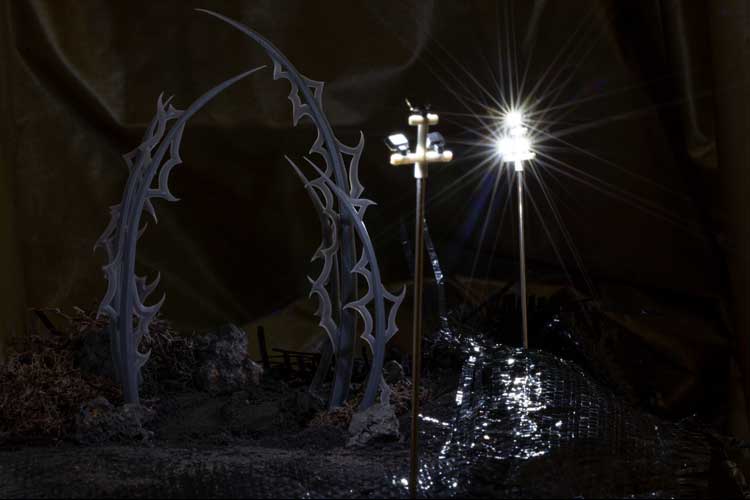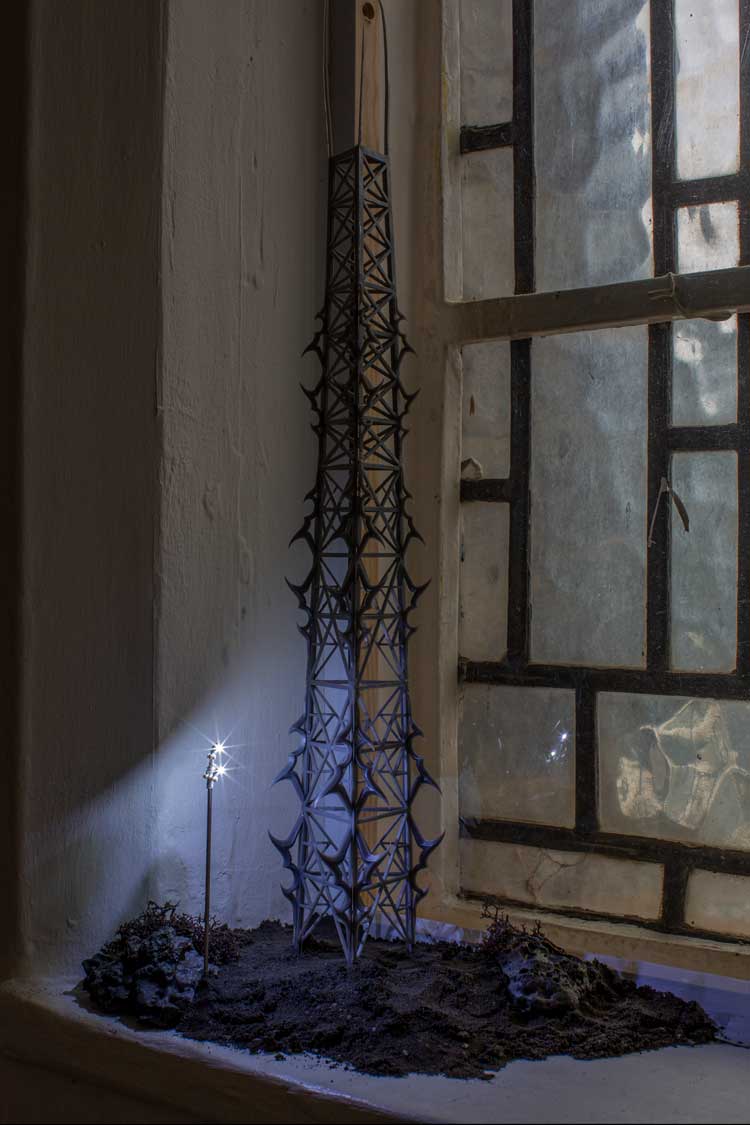
Zabludowicz Collection, London
12 January – 26 February 2023
by CHRISTIANA SPENS
Molly Erin McCarthy grew up in Cornwall and, after a few years in London, moved to Plymouth in nearby Devon. Her work invokes the natural landscape, folklore and history of her home county. For this show, a small gallery has been transformed into an interactive game space, a makeshift military bunker where small sculptural works give the sense of being part of a shrine and make “real” parts of the virtual world that plays out on a screen.
Visitors are encouraged to sit here amid sandbags and military khaki parachute material and play the interactive video game, exploring McCarthy’s digital landscape and navigating a virtual world. The space becomes a place to reflect on the often-dystopian world in which we live and an immersive apocalyptic outpost where we can escape from it. A subtle narrative reveals itself through the game, which the artist has determined, allowing for an interesting interaction between artist and players, the latter swaying between individual choices and McCarthy’s pre-created vision and story.
.jpg)
SDiAR ver.1.321618720143181418, installation view, Invites: Molly Erin McCarthy, Zabludowicz Collection, 2023. Photo: David Bebber.
In an interview with the show’s curator, Julia Greenway, McCarthy explains that she drew her influences from open-world role-playing games such as Death Stranding and The Elder Scrolls, which involve quests and exploration of digital environments; in her own game, she has created riddles and codes that piece by piece reveal a narrative and world. She says: “I was really influenced in my adolescence when home game consoles and PCs were just becoming commonplace. I was spending half my time in the beautiful landscapes of Cornwall and then half my time in digital worlds. That was all new for me: cohesive world-building games that had all these different styles and levels of engagement and interaction. The transition between a regional landscape and a digital one is very much the foundation of my practice.”

Ferry, installation view, Invites: Molly Erin McCarthy, Zabludowicz Collection, 2023. Photo: David Bebber.
As such, in the exhibition space there is a fusion of the physical and digital, and the imaginaries between them both; mysticisms of the Cornish region, and in particular Celtic symbols and mythologies, are combined with a techno-dystopian aesthetics particular to the artist’s teen years. What comes together is a strange and clever vision of a post-technological future, in which old codes and riddles co-exist with a military sensibility, as if the past is in constant tension with the present. “What I set out to create is the sublime but eerie elements of the landscape I grew up in,” says McCarthy. “The outcome is quite bleak and dystopian, but my intention was that there would be an inspired conclusion.”
This bleak atmosphere is rooted in reality; for all the mysticism and beauty of Cornwall, it is quite a deprived and isolated region and, for a young person who has grown up there, it can be difficult to leave. As McCarthy says: “[I talk] about it now in a very romantic way, but particularly as you get a bit older you can feel trapped by being from a tiny town on the edge of Cornwall and having limited opportunities and access. I have had to work very hard to live or work outside the region. I think, because of this, I’ve always sought out a level of escapism to imagine a better place for myself. I lived in London for a few years and then came back to the south-west, and I’ve learned to appreciate it so much and to really get lost in the otherworldliness of this actual real-world place.”

Ribs, installation view, Invites: Molly Erin McCarthy, Zabludowicz Collection, 2023. Photo: David Bebber.
This is where the escapist element comes into play; while there is a rustic, other-worldly nature to the Cornish landscape, there is also a feeling of a need to escape it, and this contradiction is where McCarthy finds this fascinating space and means of transformation and creativity. By using her art practice to recreate the environment she knows so well, she honours it and also escapes it. Crucially, this kind of escapism is, for McCarthy, innately subversive and empowering; in her transforming world-building, she finds a way to give herself power over a place and wider systems over which she would otherwise have no control. In Invites, she simulates a version of the world in which she does have power and freedom; she transforms what could be stifling or overwhelming into something clever and intricate. “I build worlds in which I can unpick the philosophical landscapes surrounding military, industrial and technological power structures, all of which I get to control.”

Spire, installation view, Invites: Molly Erin McCarthy, Zabludowicz Collection, 2023. Photo: David Bebber.
This aspect of her work is fascinating, and speaks to a shared feeling of needing to confront the dystopian and overwhelming nature of the world around us, and to make peace with it, as well as finding one’s own space apart from it. In creating this bunker, which is also a sort of shrine, McCarthy condenses this shared desire to retreat from the world but also to remake it and resolve it in ways that are ancient and mystical in origin. We live in the past and the future at once, and McCarthy makes a space in the present to meditate and unpack that strange, uncanny experience.
The first of its kind, this vast show is a stunning tour of the realism movement of the 1920s and 30...
Maggi Hambling: ‘The sea is sort of inside me now … [and] it’s as if...
Maggi Hambling’s new and highly personal installation, Time, in memory of her longtime partner, To...
Caspar Heinemann takes us on a deep, dark emotional dive with his nihilistic installation that refer...
Complex, multilayered paintings and sculptures reek of the dark histories of slavery and colonialism...
Shown in the context of the historic paintings of Dulwich Picture Gallery, Rachel Jones’s new pain...
William Mackrell – interview: ‘I have an interest in dissecting the my...
William Mackrell's work has included lighting 1,000 candles and getting two horses to pull a car. No...
Marina Tabassum – interview: ‘Architecture is my life and my lifestyle...
The award-winning Bangladeshi architect behind this year’s Serpentine Pavilion on why she has shun...
A cabinet of curiosities – inside the new V&A East Storehouse
Diller Scofidio + Renfro has turned the 2012 Olympics broadcasting centre into a sparkling repositor...
Plásmata 3: We’ve met before, haven’t we?
This nocturnal exhibition organised by the Onassis Foundation’s cultural platform transforms a pub...
Ruth Asawa: Retrospective / Wayne Thiebaud: Art Comes from Art / Walt Disn...
Three well-attended museum exhibitions in San Francisco flag a subtle shift from the current drumbea...
This dazzling exhibition on the centenary of John Singer Sargent’s death celebrates his versatile ...
Through film, sound and dance, Emma Critchley’s continuing investigative project takes audiences o...
Rijksakademie Open Studios: Nora Aurrekoetxea, AYO and Eniwaye Oluwaseyi
At the Rijksakademie’s annual Open Studios event during Amsterdam Art Week, we spoke to three arti...
AYO – interview: Rijksakademie Open Studios
AYO reflects on her upbringing and ancestry in Uganda from her current position as a resident of the...
Eniwaye Oluwaseyi – interview: Rijksakademie Open Studios
Eniwaye Oluwaseyi paints figures, including himself, friends and members of his family, within compo...
Nora Aurrekoetxea – interview: Rijksakademie Open Studios
Nora Aurrekoetxea focuses on her home in Amsterdam, disorienting domestic architecture to ask us to ...
Kiki Smith – interview: ‘Artists are always trying to reveal themselve...
Known for her tapestries, body parts and folkloric motifs, Kiki Smith talks about meaning, process, ...
Frank Auerbach, Britain’s greatest postwar painter, has a belated German homecoming, which capture...
How Painting Happens (and why it matters) – book review
Martin Gayford’s engrossing book is a goldmine of quotes, anecdotes and insights, from why Van Gog...
Jonathan Baldock – interview: ‘Weird is a word that’s often used to...
As a Noah’s ark of his non-binary stuffed toys goes on show at Jupiter Artland, Jonathan Baldock t...
Helen Chadwick: Life Pleasures
Helen Chadwick’s unwillingness to accept any binary division of the world allowed her to radically...
Catharsis: A Grief Drawn Out – book review
To what extent can the visual language of grief be translated? Janet McKenzie looks back over 20 yea...
Radical Software: Women, Art & Computing 1960-1991
With more than 100 works by 50 artists, this show examines the pioneering role of women in computer ...
Dame Jillian Sackler, the art lover and philanthropist, has died aged 84...
Giuseppe Penone: Thoughts in the Roots
With numerous works created with the twigs, leaves, roots, branches and majestic forms of trees, thi...
Solange Pessoa: Pilgrim Fields
An olfactory orgy of marigolds, chamomile, grasses, sheepskins and kelp is arranged into a surreal l...
Christian Krohg: The People of the North
A key figure in Norwegian art, naturalist painter Christian Krohg wanted his art to bring social cha...
This comprehensive show charts the groundbreaking rise of the illustrated poster in 19th-century Fra...
Caspar David Friedrich: The Soul of Nature
This comprehensive show celebrating last year’s 250th anniversary of the Romantic painter’s birt...
A humongous survey of contemporary painting in Belgium shows a medium embracing the burden of its hi...